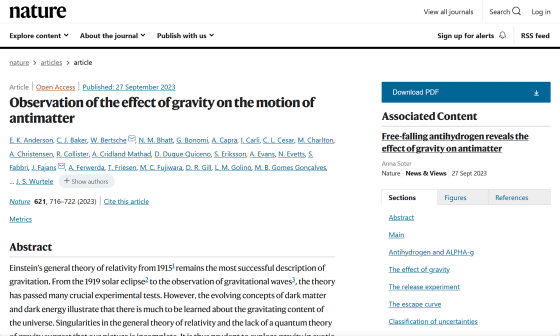CERN's experiment reveals that 'antimatter', which has the properties of a pair with matter, falls according to gravity, denying antigravity

Regarding
Observation of the effect of gravity on the motion of antimatter | Nature
https://www.nature.com/articles/s41586-023-06527-1

Antimatter embraces Earth, falling downward l | EurekAlert!
https://www.eurekalert.org/news-releases/1002671
Major CERN experiment proves antigravity doesn't exist — at least when it comes to antimatter | Live Science
https://www.livescience.com/physics-mathematics/gravity/major-cern-experiment-proves-antigravity-doesnt-exist-at-least-when-it-comes-to-antimatter
Mind-Blowing Experiment Reveals Antimatter Falls in Gravity : ScienceAlert
https://www.sciencealert.com/mind-blowing-experiment-reveals-antimatter-falls-in-gravity-just-like-matter
Antimatter is a substance that has the property of being electrically paired with normal matter. Electrons, which make up normal matter, have a negative charge and protons have a positive charge, whereas positrons , which make up antimatter, have a positive charge, and antiprotons have a negative charge.
In 1928, physicist Paul Dirac predicted the existence of antiparticles (positrons and antiprotons), positrons were discovered in 1932, and antiprotons were discovered in 1955. In 1995, a research team at CERN and other institutions succeeded in producing antihydrogen, a type of antimatter, by combining positrons and antiprotons , and subsequently succeeded in mass producing antihydrogen in 2002.
When antimatter collides with normal matter, it undergoes annihilation , and in exchange for the loss of mass, energy is released. However, it is believed that equal amounts of matter and antimatter were created in the Big Bang , the beginning of the universe, and despite this, in the modern universe, for some reason, only antimatter has unilaterally disappeared, and matter now makes up most of the universe. This creates an asymmetry.
As a theory that may resolve this contradiction, some scientists believe that ``antimatter has antigravity, which separated matter and antimatter in the early universe, creating the asymmetry of the current universe. ” is proposed. Many scientists are skeptical of this theory, but since no experiments have been conducted to directly observe the effect of gravity on antimatter, it seems difficult to be convinced that this theory is wrong.

Therefore, an international research team from CERN and the University of California conducted an experiment to confine antihydrogen, an antimatter, in a cylindrical magnetic chamber and investigate whether it is affected by gravity. You can get a better idea of what the experiment was like by watching the video below.
Antihydrogen is antimatter produced when antiprotons capture positrons.

The international ``Antihydrogen Laser Physics Apparatus (Antihydrogen Laser Physics Experiment Apparatus: ALPHA)'' collaborative research team trapped approximately 100 generated antihydrogens in a magnetic bottle approximately 25 cm in length. The temperature of the antihydrogen trapped in the magnetic bottle is 0.5

In the experiment, by gradually weakening the magnetic field of this magnetic bottle, antihydrogen was allowed to escape from the bottle little by little, and it was detected whether more antihydrogen had flown to the top or bottom of the bottle. If the bottle is vertical, and the antihydrogen inside is affected by gravity like normal substances, more antihydrogen will escape downward than upward. Co-author Joel Fajans , a physicist at the University of California, Berkeley, said the experiment was like putting objects of nearly the same weight on a balance, allowing them to observe the tiny amount of gravity acting on antimatter. It is explained that it is something to do.

As a result of repeated experiments, it was observed that about 80% of the antihydrogen escaped downward. This showed that gravity is acting on antihydrogen, and antigravity is not working.

The results of this experiment confirm the mainstream theory that ``gravitational force acts on antimatter.'' 'If you walk down the halls of a physics department and ask any physicist, they'll all say, 'This result doesn't surprise me in the slightest,'' said study co-author Jonathan Urtel, a plasma physicist at the University of California, Berkeley. 'They would say, ``That's the reality. But most of them weren't sure about that, so the experiment needed to be done.''
Related Posts:







